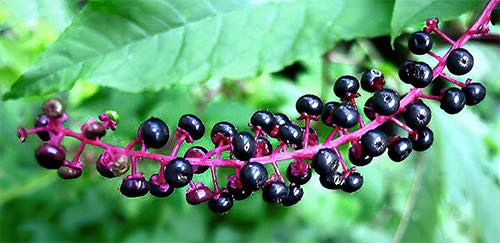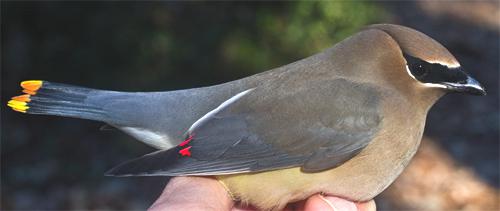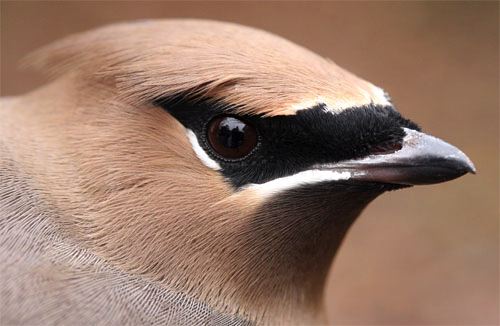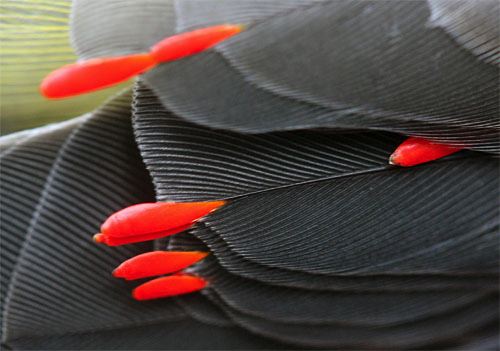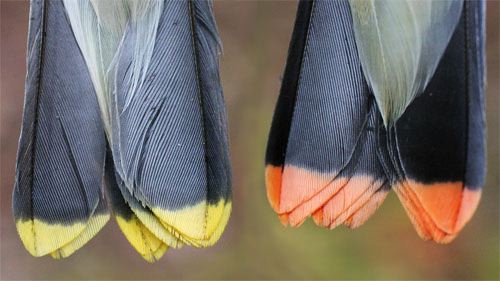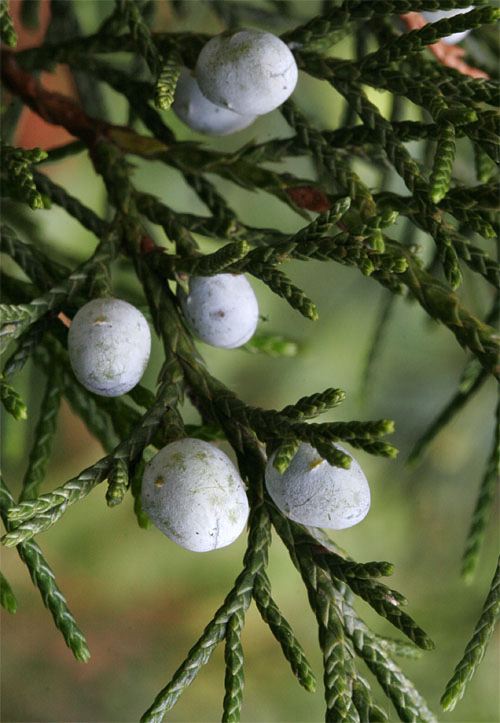- Established 1982 -HOME: www.hiltonpond.org
THIS WEEK at HILTON POND Subscribe for free to our award-winning nature newsletter (Back to Preceding Week; on to Next Week) |
(immature male Rufous Hummingbird at right) |
PURPLE-POOPING WAXWINGS IN OUR When we replaced a septic tank and drain field this past spring at Hilton Pond Center--just beyond our main bird feeding and trapping station near the old farmhouse--we were concerned how it might affect local flora and fauna and our avian research. We had been mowing the quarter-acre section regularly to keep tree roots out of the leach lines, so for 41 years it has been mostly open habitat with good viewing of birds as they came and went.
All text, maps, charts & photos © Hilton Pond Center The septic installers, by necessity, dug up the entire area to bury the new tank and lay two long drain lines, being careful not to damage shrubs around the border. (We're not sure about the future of that tall Chinese Chestnut beside the open trench in the photo above. A lot of its roots got cut by the excavator, so we suspect soon it will die and become a woodpecker snag. That tree came up on its own about 25 years ago.) The crew also did a great job leveling and smoothing upturned soil--mostly red clay that for a few months during spring rains was a morass of red mud.
All text, maps, charts & photos © Hilton Pond Center By early summer, however, things dried out a little and dozens of American Pokeweeds, Phytolacca americana, sprouted across much of the bare soil. Apparently septic tank disturbance had cultivated the earth to pokeweed's liking, with seed lying dormant for who knows how long and jumping at the chance to germinate. By summer's end the plants had grown prodigiously and we had our own pokeweed forest (as shown above, with lots of drooping leaves killed during cold weather in late October). Our photo does not do these purple-stemmed plants justice; without something for scale you can't tell several are eight feet tall.
All text, maps, charts & photos © Hilton Pond Center From our plentiful purple-stemmed pokeweed plants soon came a plethora of pokeweed flowers that yielded thousands of dangling pokeweed berries going from green to purple-black as they ripened (above). Purple pokeweed fruit inevitably is followed, of course, by purple pokeweed-eating birds that reveal their diet-- placing purple pokeweed poop on the hands of bird banders or on soon-purpled yard furniture and other previously purple-less painted places. Our newly grown purple pokeweed patch was a salad bar for berry-lovers from Gray Catbirds to Northern Mockingbirds to American Robins. These birds entertained us by the hour as they raided the pokeweed larder, stuffing their crops with juicy purple fruit. Little did we know a new septic tank installation would offer such enjoyable purple pokeweed-related wildlife observation opportunities.
All text, maps, charts & photos © Hilton Pond Center By early November, most ripe pokeweed berries in the tract had been consumed, but enough were still hanging to attract the attention of one bird species we encounter only sporadically at Hilton Pond Center, usually during cold-weather months: Cedar Waxwings (CEDW, adult above). Most years we see CEDW every several weeks during the winter as this nomadic, highly social species wanders the countryside looking for food. Surprisingly, each morning for the past two weeks a flock of hungry waxwings has dived into our pokeweed jungle, thrashing about as they gorge on remaining purple pokeweed berries. There is constant rustling until the waxwings have taken in all they can hold, after which they whoosh off for some locale bound sure to benefit vegetatively from seed-laden purple pokeweed poop the birds will donate without charge.
All text, maps, charts & photos © Hilton Pond Center As might be expected, some of these Cedar Waxwings have gotten caught in mist nets we deploy to capture birds for banding. We extract them carefully--on top of pooping purple they also have slightly hooked upper mandibles (above) that can pinch a bander's fingers. (NOTE: During net extractions we ALWAYS aim waxwing cloacas in the opposite direction.) This fall we've banded 20 CEDW--about 7% of our total of 303 since 1982. (Most years we capture none; our record high is 44 in 1991.)
All text, maps, charts & photos © Hilton Pond Center Of this year's 20 waxwings, only four have been adults, and several seemed almost brand new--recent fledglings we wouldn't expect so late in the year. As shown above, these youngsters had undeveloped crests, light-colored soft gapes (corners of the mouth), unkempt plumage, and uneven light breast streaking--all signs they weren't very long out of a nest. (See typical nest below, made of pine needles, grasses, rootlets, and bark strips and festooned with lichens, in a spruce tree).
All text, maps, charts & photos © Hilton Pond Center Doing a bit of on-line research, we consulted Cornell's "NestWatch" account and learned: Because foods they require are usually most abundant later in summer, Cedar Waxwings are a relatively late-nesting species. Egg-laying typically begins in June and continues through August, and active nests have been found as late as October. Thus, having very young birds show up at Hilton Pond in November isn't such an anomaly after all. Even so, these immature CEDW we caught must have been mature enough to fly some distance; the South Carolina Breeding Bird Atlas shows very few records for the state--most in the northwestern Mountain Region. They nest commonly across the continental U.S. north of the 35th parallel and in almost all of Canada.
All text, maps, charts & photos © Hilton Pond Center In our two profile photos above you'll notice only the adult Cedar Waxwing has red waxy tips on its secondary wing feathers. These structures, which give the species its common name, typically increase in number in successive molts as the bird ages, although some younger CEDW can show as many as five red tips. Older individuals can have up to nine and it's interesting breeding studies show birds with more tips (as above) tend to mate with others of their ilk. Of the 20 birds banded locally this year, only two had any red tips at all--further evidence the Center's current pokeweed-eating flock is made up primarily of young birds. (Note that red tips do NOT indicate a waxwing's gender. Sex of an adult CEDW often can be determined by the extent of black chin feathers--greater in males.)
All text, maps, charts & photos © Hilton Pond Center Our upper profile photo of the adult Cedar Waxwing also shows it has several central tail feathers with orange tips, rather than the usual yellow. This reveals at the time the orange-tipped feathers were coming in the waxwing was dining on something different"--in all likelihood berries from invasive non-native Tatarian (not "Tartarian") Honeysuckle, Lonicera tatarica, that contain pigments apparently not found in native berries waxwings typically eat. (The color phenomenon might be caused by other plants, too, such as ornamental Pyracantha spp.) The CEDW at right in the tail photo just above must have had a steady diet of Tatarian Honeysuckle, perhaps as a nestling in which its first set of tail feathers all came in at the same time.
All text, maps, charts & photos © Hilton Pond Center We realize some homeowners would not take kindly to a massive monoculture of American Pokeweed sprouting in the backyard and making purple berries with a high purple poop potential, so if you still want to attract Cedar Waxwings in winter you might opt instead for any of several native shrubs or trees. Included in this group are the waxwing's namesake tree Eastern Red Cedar (Juniperus virginiana, above)--although maybe these birds should be called Pokeweed Waxwings instead! Two other choices include native varieties of Hawthorns (Crataegus spp.), Crabapples (Malus spp.), or Winterberry (Ilex verticillata, below).
All text, maps, charts & photos © Hilton Pond Center Thanks in large part to hungry frugivorous birds, most of our purple pokeweed fruits have disappeared by now, but thousands of uneaten seed-laden berries undoubtedly dropped to the ground where they await the right conditions to germinate. On top of that, American Pokeweed is a perennial herbaceous plant; even though the current purple stems die back each winter roots are alive, ready to give rise to new growth.
All text, maps, charts & photos © Hilton Pond Center All this means Hilton Pond Center's already ponderous Purple-stemmed Purple-berried Phytolacca Pokeweed Patch is probably primed to populate profusely next spring, propagating past present parameters and probably pulling in a peppy flock of purple-pooping Cedar Waxwings in Fall '23. We'll have to postpone our possible pleasure 'til then. (For now we're off to eat some of Peter Piper's pickled peppers.) All text, maps, charts & photos © Hilton Pond Center ROOTLESS DUCKWEED "TAMED"
All text, maps, charts & photos © Hilton Pond Center It was too breezy today on 8 November at Hilton Pond to deploy mist nets to catch birds for banding. In advance of Hurricane Nicole, it was gusting to 20+ mph. One good thing was the wind pushed all that dastardly Rootless Duckweed to one side so we can actually see the pond for the first time in months. Happy Fall! All text, maps, charts & photos © Hilton Pond Center HILTON POND SUNSETS "Never trust a person too lazy to get up for sunrise
All text, maps, charts & photos © Hilton Pond Center Sunset over Hilton Pond, 06 November 2022 Rain finally dispersed after dropping 1.56" over seven days, All text, maps, charts & photos © Hilton Pond Center Don't forget to scroll down for lists of Hilton Pond supporters and of all birds banded and recaptured during the period. Photoshop image post-processing for this page employs |
|---|
|
"This Week at Hilton Pond" is written and photographed by Dr. Bill Hilton Jr., executive director of Hilton Pond Center for Piedmont Natural History
|
|
|
Please refer "This Week at Hilton Pond" to others by clicking on this button: |
|

 Oct 15 to Mar 15:
Oct 15 to Mar 15:

